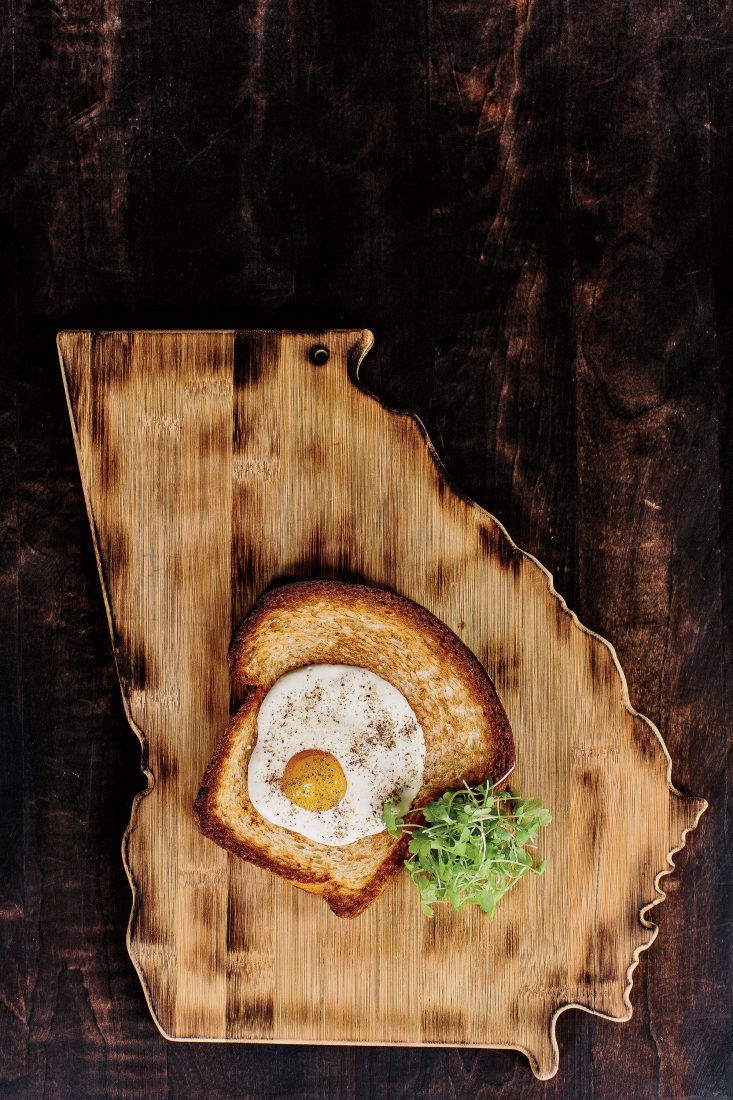Let’s get my thirteen-year-old son’s disappointment out of the way first. “This dessert is magic,” Jess said, smiling big and dipping a shard of chocolate from my mint cookie cake into a puddle of warm banana pudding that quivered beneath a high fade of poofy meringue. “But I wish the chef would do more with munitions. He could name the dishes after guns. And maybe he could name the drinks after different calibers.”
From the name itself to the machine-shop vibe of the interior, Gunshow, which chef Kevin Gillespie opened in the Glenwood Park neighborhood of Atlanta in 2013, has suffered at the hands of lesser critics than Jess. The most persistent complaints have been directed at the modified dim sum service style, in which the cooks who sweat it out on the line—rolling and deep-frying cigar stubs of lamb-threaded samosas, or chopping collards into chiffonade beds for cornmeal fried oysters—also serve as waiters, delivering dishes to the long plank tables for the guests’ perusal while talking them through ingredients and inspiration, squatting or stooping tableside like supplicants before their sires.

Photo: Andrew Thomas Lee
Atlanta chef Kevin Gillespie.
Those critiques fall flat in the face of what Gillespie—who grew up in a suburban Atlanta trailer park and turned down a scholarship to MIT to study culinary arts—has accomplished. His restaurant serves dishes like roasted diver scallops and beef Wellington while calling into question our assumptions about how class and status are negotiated among the dining public. Gillespie serves luxurious food, prepared with the best ingredients. But he rejects the trappings of luxury. His approach reminds me that, even in this starstruck culinary moment, chefs are servants, not masters.
The interior at Gunshow is purposefully stark. Wire shelving, stacked with jugs of vinegar and soy, lines the walls. T-shirts, displayed by the register, recall souvenirs sold from the arena steps at a Van Halen show. Overhead lighting is harsh and fluorescent. To walk through the front door is to cross the transom of a better-smelling auto shop, where the stereo blares high school rock and roll, and the crew seemingly just pivoted from disemboweling a carburetor to boning out a forequarter of prime beef.
I ate my first Gunshow meal with Jess at a low-rise counter facing the kitchen, visible through an acrylic divider like the ones that keep pucks from hitting hockey rink crowds. Watch the chefs dish apps of goat mole with tomatillo or razor clams with Calabrian chile sauce, that divider suggested, but mind the tortilla shrapnel.

Photo: Andrew Thomas Lee
À La Cart
Plates roll out of the kitchen.
The ringside style of service is humbling for the young chefs Joseph Ward and Andreas Müller, who fuel Gillespie’s kitchen. It’s humbling for diners, too. If you don’t like the look of a dish, if a beef tartare Reuben that recalls the floor of a mustard-seed-scattered terrarium, or a chile relleno bulging with smoked mushrooms, doesn’t entice, you have to tell your server while he stands before you, doe-eyed and beaming with pride in his creation.
During my second dinner, with a rowdy group of friends, I discovered that those tableside visits could lead to overzealous orders. Like a second rib of pork, carved to order. Or a close-of-the meal hunk of roasted foie gras with pistachio-truffle baklava. Both came with bashful smiles from chef-servers. Both jacked our bill higher. Neither disappointed.
It’s common today for a chef to refer to his or her cuisine as personal, especially in a restaurant like Gunshow, where the dishes don’t hew to one style but riff on many, reflecting, variously, the chef’s birthplace, schooling, and travels. That said, too few chefs today actually cook food that reveals something about themselves. With Gunshow, Gillespie reveals much. About his upbringing. About his idea of leisure. About how he sees himself and his region.

Photo: Andrew Thomas Lee
Georgia olive oil-poached halibut.
From day one, Gillespie has been forced to explain himself and his intent, beginning with that name. Jess and I learned the story of Gunshow on that first visit, when we asked one of the roaming chef-servers about how the name came into use. It honors Gillespie’s father, who worked six and seven days a week to support his family. On Sundays when the elder Gillespie managed an afternoon off, he escorted young Kevin to gun shows, where they would walk the aisles, ogle the rifles, and talk the nurturing talk of fathers and sons.
For a man like Gillespie, who won fame on season six of Top Chef and has since ascended to the upper ranks of Southern chefs, Gunshow serves as a very personal reminder of the place from which he sprang. For diners like me and you, a meal under his roof serves larger purposes, reminding us all that, no matter the current vogue for haute Southern cuisine, our food and our people claim honest roots in the working-class aesthetic that Gunshow celebrates.








